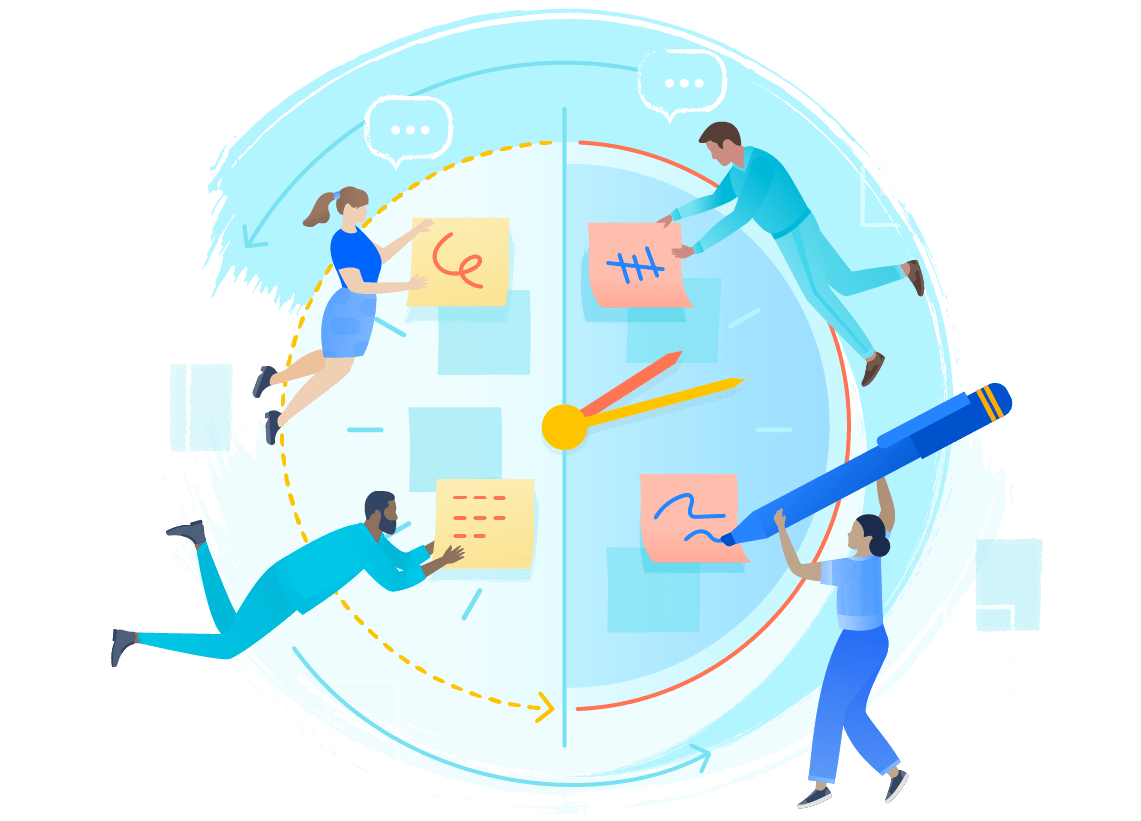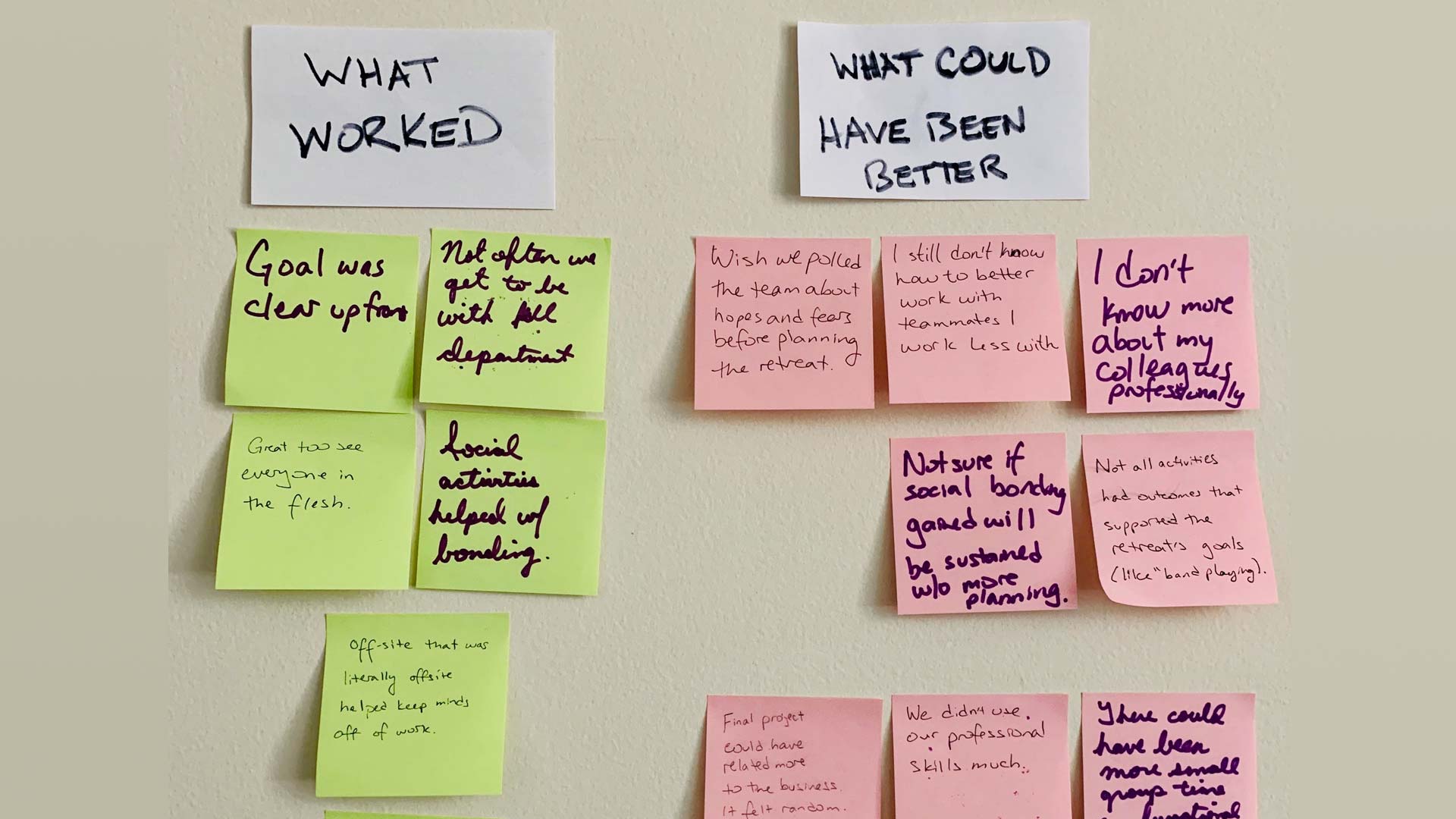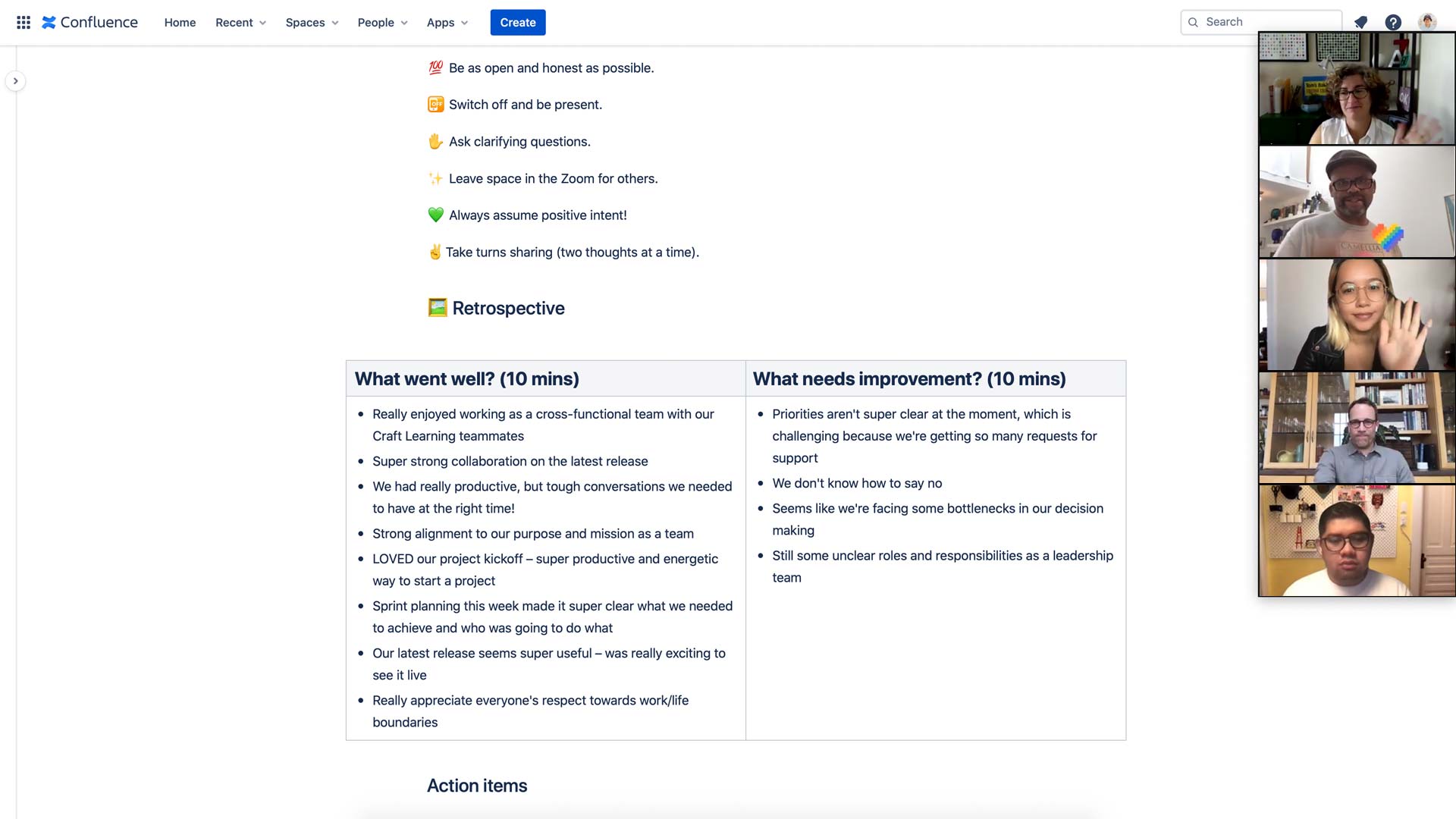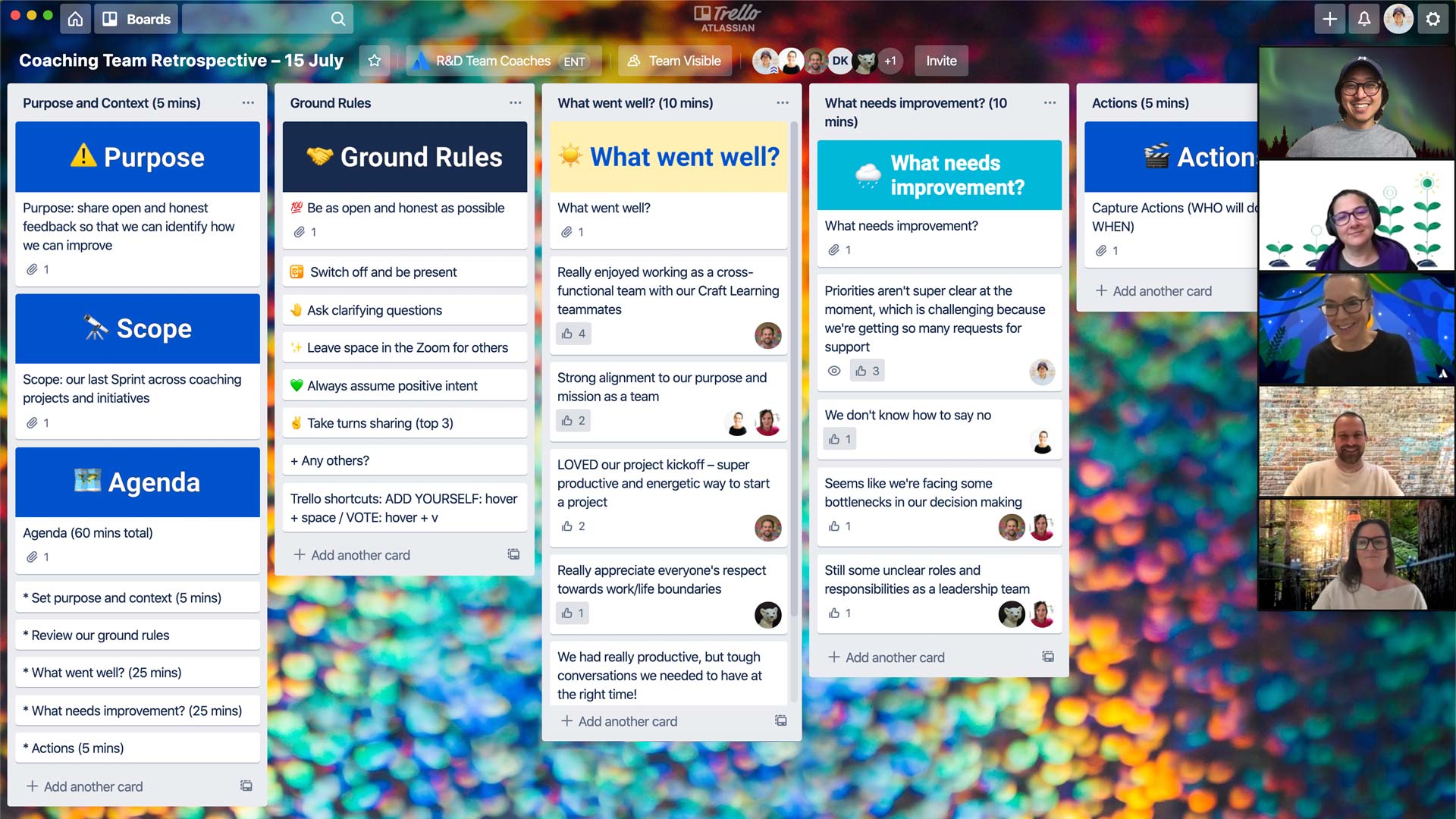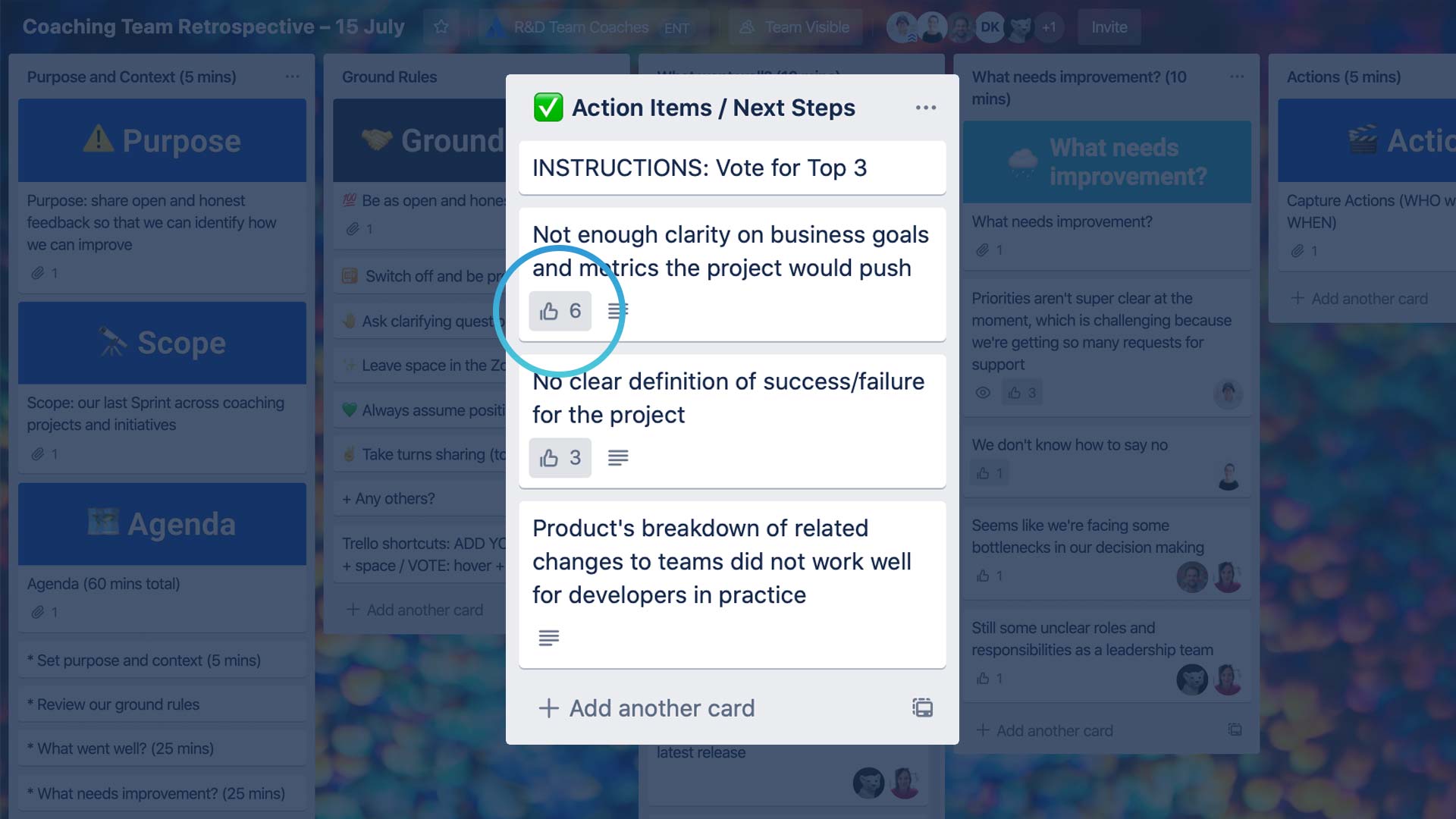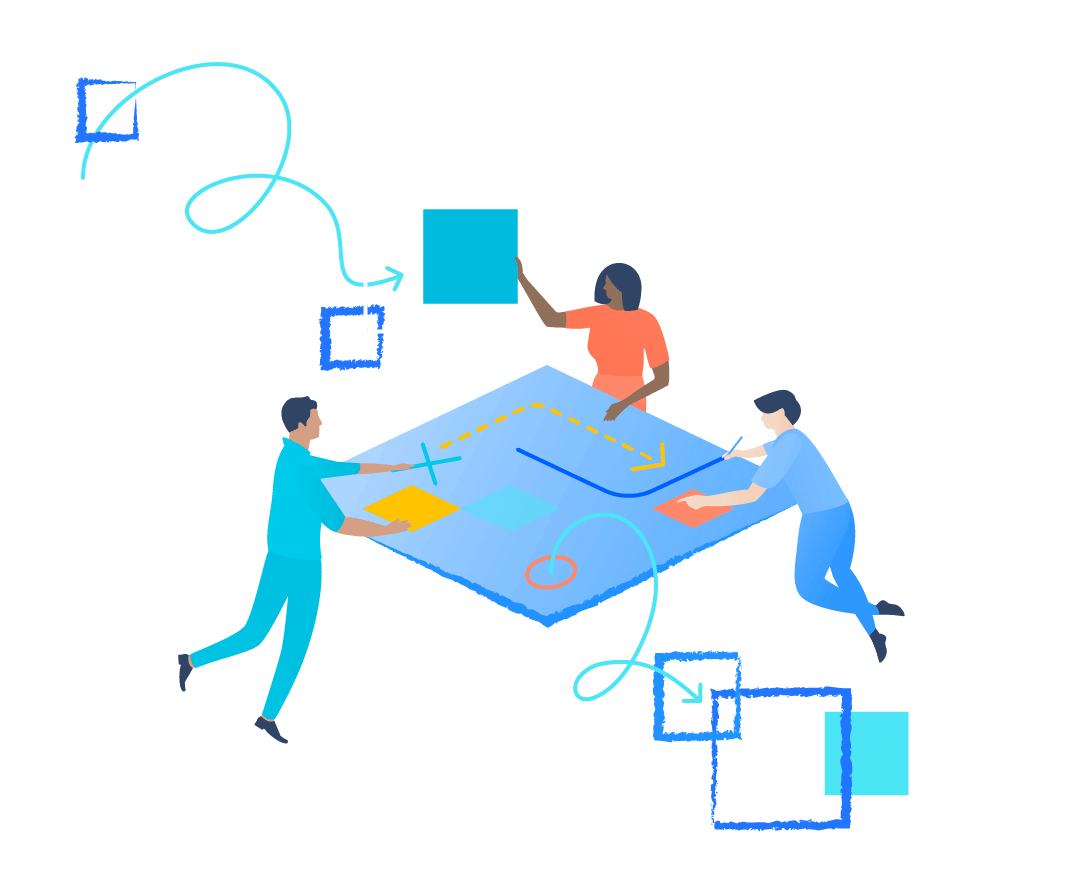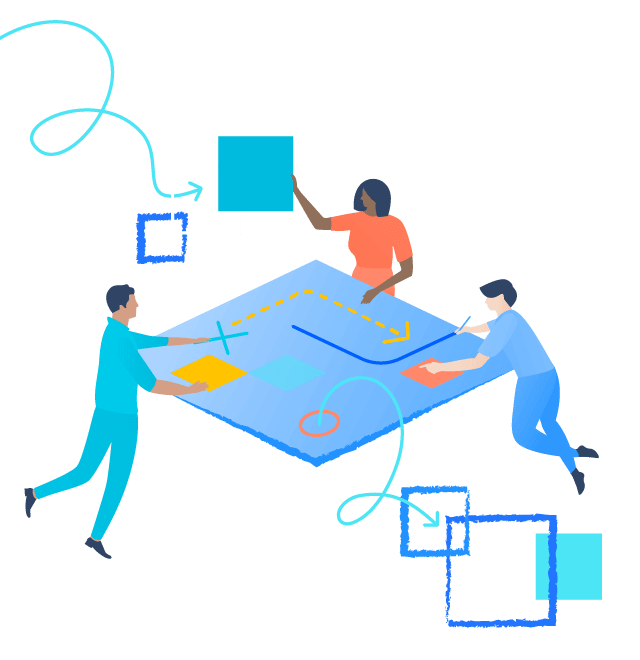スプリントのふりかえりとは
スプリントのふりかえりは、アジャイル手法において重要な役割を果たすスプリントの後に行われるレビューです。スプリントのふりかえりの目的は、何がうまくいったか、どこに問題があったかを調べ、改善できる部分を特定することです。
定期的なレビューは、チームのコラボレーションに不可欠です。何がうまくいき、何がうまくいかないかを理解することで、アジャイル・プロセスを改善して次のスプリントを簡素化できます。
スプリントのふりかえりミーティングには誰が参加すべきか
スプリントのふりかえりミーティングには、製品所有者、スクラム・チーム、スクラム・マスター、関係者が参加すべきです。スプリントのふりかえりミーティングでは、さまざまな視点があるのはよいことです。プロジェクトの次の部分を開始する前に、全員が協力して直近のスプリントを分析し、どのような変更を行う必要があるかを判断できます。
スプリントのふりかえりはなぜ重要なのか
スプリントのふりかえりを実施することで、以前の取り組みから学び、将来のスプリントを改善することができ、それがスクラム・スプリントの合理化とより良い最終結果につながります。スプリントのふりかえりを使うメリットは次のとおりです。
- 継続的な改善を促進する
- チームのコラボレーションを強化する
- 問題解決を促す
- ミスの繰り返しを防ぐ
- その結果、成果物の品質が向上する
- チームの士気を高める
ふりかえりの実施
オフサイトでのふりかえりからのチームの付箋。
このチームは、Confluence を使用してふりかえりの会話をまとめました。
Trello を使用した Zoom でのふりかえり。基本ルールを設定し、意見を追加し、議論を導きます。
前提条件
リモート
画面共有を使用したビデオ会議
デジタル コラボレーション ツール (テンプレートを参照)
対面
ミーティング スペース
ホワイトボードまたは大きな用紙
マーカー
付箋紙
タイマー
推奨テンプレート
スプリントのふりかえりミーティングを成功させるための 5 つのステップ
ふりかえりテンプレートを使用することに加えて、いくつかの簡単なステップに従うことで、スプリントのふりかえりミーティングを成功させることができます。チームの全員が、ミーティングへの参加を歓迎されていると実感できるようにします。フィードバックを収集したら、そのフィードバックを分析して、改善のためのアクション アイテムを作成できます。
スプリントのふりかえりミーティングを成功させるための 5 つのステップは次のとおりです。
ステップ 1:方向性を設定する
方向性を設定することは、スプリントのふりかえりを実施する最初のステップです。スプリント計画の目標は、さまざまな視点からフィードバックを収集し、そのフィードバックを使って目標を設定し、アジャイル・プロセスを改善することです。全員がスプリント・レビューでの発言権があると認識すべきであり、その方向性をミーティングの開始時に設定しましょう。
スプリントのふりかえりでは、参加者にフィードバックの共有と、貴重なインサイトの提供を促しましょう。誰かの間違いを非難するのではなく、改善に焦点を当て、誰もがオープンかつ正直にコミュニケーションできるようにします。
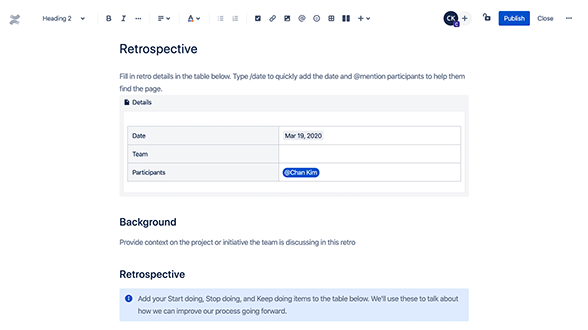
例: Confluence
このプレイをリモートで実行していますか? この無料のふりかえりテンプレートを使用して、会話を進め、セッションの成果を取り込みます。
ステップ 2:フィードバックを収集する
方向性を設定して、あなたが求めているインプットの種類を全員が把握したら、チーム メンバーのフィードバックを収集できます。4 L モデルによるふりかえりは、スプリント中に一人ひとりが気に入ったこと、嫌だったこと、学んだこと、望んだことを尋ねてフィードバックを集める 1 つの方法です。詳細なフィードバックを提供するのが難しい場合は、4 つの L を使うのが基本的なガイドラインです。
スプリントのふりかえりで全員からフィードバックを収集するには、さまざまな方法があります。全員が同意すれば、グループ・ディスカッションを行えます。また、チーム メンバーにアンケートに回答してもらったり、次のスプリントの改善に役立つ匿名のフィードバックを送信してもらったりすることもできます。
ヒント: このリストをカスタマイズする
チーム独自のニーズに合わせてルールを変更してください。チームの改善に役立つと思われる内容を追加してください。
ヒント: 安全なスペースを設ける
プレイの後に情報についてどのように話し合うかを定義してください。その情報をリーダーシップと共有しますか? チャタム ハウス ルールを採用することを検討してください。
ステップ 3:インサイトを得る
フィードバックを収集することは、スプリントのふりかえりを実施する場合の大変な作業の一部に過ぎません。そのフィードバックを行動に移す必要があります。受け取ったフィードバックを分析して、チームと前のスプリントについて理解を深めるのに役立つパターンや傾向を探します。
これらのインサイトは目標設定の重要な部分なので、全員でコラボレーションして貴重なインサイトを提供してもらいます。スプリント・レビュー・ミーティングで異なる視点を持つことがいかに重要かについてはすでに述べました。これはインサイトを生み出すときに明らかになります。
ステップ 4:アクション アイテムを作成する
アジャイル チームと直近のスプリントの詳細を確認したら、それらのインサイトをアクションにつながるアイテムに変えることができます。ここから、目標の設定を始めて、将来のスプリントのためにどのような変更を行うかを決定できます。
SMART 目標(具体的(Specific)、測定可能(Measurable)、達成可能(Achievable)、関連性(Relevant)、期限が明確(Time-bound))を設定することが不可欠です。SMART 目標を設定することは、成功を達成するために不可欠であり、目標を達成可能にし、会社にとって適切な結果がもたらされるようにします。
ヒント: 全員の発言に耳を傾ける
話し合いを 1 - 2 人が支配している場合、進行役は話し合いを進める前に介入し、他の人に発言を求める必要があります。
ステップ 5:ふりかえりを締めくくる
前回のスプリントから学び、次のスプリントを改善するためのステップを実行したので、スプリントのふりかえりミーティングを締めくくります。ミーティングから得た重要なポイントを要約し、ミーティングに貢献してくれた全員に感謝の意を表して、終了を伝えます。
スプリントのふりかえりミーティングを終えるときは、努力を無駄にしないように、明確な実施計画を立てる必要があります。変更をどのように実施するかを把握することは、スプリント・ミーティングの重要な部分です。
ヒント: ワークフローを更新する
Jira 課題に対応しているアクション アイテムがある場合は、ページにその課題へのリンクを追加して、状況をすぐに確認できるようにしてください。
スタンドアップ、または週次のチーム状況の更新にかかわらず、ふりかえりから得たアクションを日々の作業に組み込みます。
スプリントのふりかえりミーティングのアイデア
アジャイル チーム・リーダーの仕事は、スクラム ボードの基本を理解することにとどまりません。貴重なインサイトを生み出すためにミーティングを主導しなければなりません。スプリントのふりかえりの例を見ると次のスプリントのふりかえりミーティングのアイデアを練るのに役立ち、プロセスを合理化し、貴重なフィードバックを収集できます。
4 L 手法を使うと、チーム メンバーにフィードバックと、何がうまくいったか、改善すべき点は何かについて思いついたことを提供してもらうことができます。
悲しい(sad)、腹立たしい(mad)、うれしい(glad)フレームワークを使って、次回のスプリントのふりかえりでディスカッションを行うこともできます。チームにフィードバックを提供してもらうためのテンプレートとなる、以下の 3 つの列を作成するだけです。
- 悲しい:何にがっかりしましたか?改善の余地があると感じた部分はありますか?
- 腹立たしい:何が不満でしたか?ベストを尽くすのを妨げているものがありましたか?
うれしい:プロジェクト期間中のどんな時間が好きでしたか?うまくいった点は何でしたか?
スプリントのふりかえりでディスカッションを促すには多様な方法があるので、ためらわずに試して、ミーティングを活性化しましょう。チームによっては匿名のフィードバックが好まれる場合もありますが、何の問題もありません。スプリントのふりかえりを調整して、チームにとって何が効果的かを判断できます。
スプリントのふりかえりミーティングのアイデア
スプリントのふりかえりは、最初は困惑するかもしれませんが、かなりわかりやすいコンセプトです。スプリントのふりかえりテンプレートを使うか、このガイドに記載されている 5 つのステップに従って進められます。フィードバックを収集し、それを使用してインサイトを生み出し、変更を実施していれば、正しく実行できています。
すべてのスプリントのふりかえりは、スプリントの成功から始まります。Jira には、スプリントを成功させるのに役立つ主な機能がいくつかあります。
- バックログ:バックログを使うと、プロジェクトやイニシアチブに関連するすべての作業を一覧表示できます。この作業を個々のスプリントに分割できます。通常は 2 週間です。
- ボード:Jira ボードを使用すると、大規模なプロジェクトをより管理しやすい部分に分割できるので、スプリントを計画して、成果物をより早くリリースできます。
- タイムライン:タイムラインは、マッピングされた作業項目、依存関係、リリースを含むプロジェクト・タイムラインの概要を示し、チームが関係者と同期を維持できるようにします。
Jira を使用すると、アジャイル チームはスプリントを簡単に視覚化、追跡、管理できます。次のスプリントを効率化して、スケジュールどおりに成果物を提供できます。Jira スクラム ボードを試して、Jira がアジャイル チームの最適化にどのように役立つかご確認ください。
スプリントのふりかえり:よくある質問
スプリントのふりかえりでよくある課題は何ですか?
フィードバックの欠如は、スプリントのふりかえりの潜在的な課題のうち、最大のものの 1 つです。参加者が透明性を保てなかったり、詳細なフィードバックを提供できなかったりすると、何がうまくいったか、何がうまくいかなかったかを判断するのが難しくなります。SMG(悲しい(sad)、腹立たしい(mad)、うれしい(glad))手法や 4 L 手法など、スプリントのふりかえりにシンプルな構造を用意することで、より良いインプットを促すことができます。匿名の投稿を収集することもできます。
また、一度の間違いや成功に焦点を当てることは避けるべきです。スプリントのふりかえりは次のスプリントの改善に関するものであるため、プロジェクトの他の部分に影響を与えないようなフィードバックに焦点を当てることは避けましょう。
スプリントのふりかえりミーティングにはどのくらいの時間をかけるべきですか?
スプリントのふりかえりミーティングの長さは、スプリントの期間によって異なります。スプリントのふりかえりは、最短で 45 分、最長で 3 時間です。すべてスプリントによって異なります。すべてに効率を追求する一方で、スプリントのふりかえりではチームが有意義な議論を行い、進歩を遂げるための十分な時間を与えることが重要です。
スプリントのふりかえりではどんな質問をすべきですか?
スプリントのふりかえりでディスカッションを盛り上げる方法はいくつかあります。4 L 手法を使って、スプリントで気に入ったこと、嫌だったこと、学んだこと、望んだことを参加者に聞くことができます。悲しい(sad)、腹立たしい(mad)、うれしい(glad)手法を使って、直近のスプリントを深く掘り下げることもできます。スプリントのふりかえりで尋ねる質問には、次のようなものがあります。
- 何がうまくいきましたか?
- どんな不具合ですか?
- 何を学びましたか?
どのような変更を実施できますか?
私たちのチームからあなたのチームへ
毎月のニュースレターで最新のプレイ、ヒント、コツについて最新情報を入手できます。
